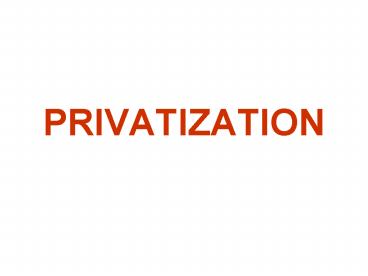PRIVATIZATION - PowerPoint PPT Presentation
Title:
PRIVATIZATION
Description:
Taxi service. water from well in town. square. Bus service. Piped water ... Government vending (Local public schools accept out-of-district pupils and is paid ... – PowerPoint PPT presentation
Number of Views:80
Avg rating:3.0/5.0
Title: PRIVATIZATION
1
PRIVATIZATION
2
TOPICS
- The welfare State
- The crisis of the Welfare State
- The foreign debt crisis in developing countries
- The neo-liberal State
- Privatization forces
- Typology of goods and services
- Forms of Privatization
- A political view of privatization
3
The Welfare State
- According to J. OConnor the State tries to
fulfill two basic but contradictory functions 1)
Accumulation (conditions for capital to be
profitable) and 2)Legitimization (social harmony)
- State expenditures have a double character that
correspond to the States two basic functions of
accumulation and legitimization - Thus expenditures take the form of social capital
and social expenses
4
The Welfare State
- Social capital expenditures are considered inputs
and they are required for profitable capital
accumulation (output) and they take the form of - Social consumption (investment that lowers the
reproduction costs of labor and increase the rate
of profits social insurance) - Social investment (projects and services to
increase productivity of labor roads and
education) - Social expenses projects and services required
to maintain the social harmony to fulfill the
legitimization function of the State (e.g. safety
net for the poor)
5
The crisis of the Welfare State
- The crisis of the Welfare State can be traced to
the 1970s worlds recession, induced by high oil
prices. - The capacity of the Welfare State to fulfill one
of its basic functions (accumulation) was
questioned. - The surged simultaneously of high inflation and
unemployment (stagflation) questioned severely
Keynesian macroeconomic management. - Economic policy shifted from Keynesianism (fiscal
policy and demand side) to monetarism (interest
rates and supply side).
6
Foreign debt crisis
- Developing countries all over the world borrow
heavily due to low interest rates and high
liquidity generated by petrodollars. - Investment in many cases went to unproductive
areas (subsidies, white-elephant projects) - As interest rates begin to increase due to
monetary policies in the developed world the
ability to repay loans was questionable. - The IMF and the World Bank offered advice to
developing countries to undertake structural
adjustment policies in exchange for financial aid
and debt restructuring
7
The foreign debt crisis
8
- Top ten borrowers as Dec.1982 FROM private banks
(Wood 1986258) - Debtor billions
- 1 Mexico 62.9
- 2 Brazil 60.5
- 3 Venezuela 27.5
- 4 Argentina 25.7
- 5 S. Korea 23.3
- 6 Phillipines 12.6
- 7 Chile 11.6
- 8 Indonesia 10.0
- 9 Malaysia 8.7
- 10 Nigeria 8.5
- International Reserves Assets of Selected OPEC
countries (Aliber 1987142) - Millions of US Dollars
- Year S.Arabia Kuwait
- 1950 0 50
- 1960 167 72
- 1970 543 117
- 1976 26,900 1,702
- 1980 23,437 3,928
- 1984 24,748 4.,590
Aliber 1987142
9
The Neoliberal state
- Y C I G (X-M)
- Consumption (the market as exchange and
allocation mechanism) - Investment (create new opportunities for capital
accumulation) - Government (reduce its share by cutting social
expenses and adopting fiscal discipline) - Net exports capital becomes global and the world
becomes a giant network of suppliers and
producers
10
The Neoliberal State
- Promotion of the primacy of private property
rights (pre-eminent in relation to other rights)
- The market as a panacea (allocation of G S by
means of private mechanisms). - Deregulation privatization of the economy
- Transformation of the tax structure (burden place
on wages rather than capital) - Downsizing of government
- Reduction of national debt (fiscal discipline)
11
Privatization Forces
Sources E.S. Savas 2000 6
12
Typology of G S
Feasible Exclusion Infeasible
Individual goods
Common pool goods
Private car Sea water Bottled water Water
in underground aquifer Taxi
service water from well in town
square Bus service Piped water Turnpike
Highway City street
individual
consumption
Joint
Collective goods
Toll Goods
Source E.S. Savas 200044-45
13
Typology of G S
Feasible Exclusion Infeasible
Individual goods
Common pool goods
individual
The Neo-liberal State
The Welfare State
consumption
Joint
Collective goods
Toll Goods
Source Adapted from E.S. Savas 200044-45
14
Forms of privatization (The case of Education)
Sources E.S. Savas 2000 88
15
A political view of privatization
- P.A. and Economics treat privatization as a
choice among means to achieve a social goal. - Privatization becomes essentially a technical
decision based on issues such as exclusion and
joint consumption of the good - Privatization should be seen as a political
decision which takes the form of a strategy to
realign institutions and decision making to
foster the interest of some groups over competing
interests - The above view is the same as OConnor which
states that class struggle is present in the
budgets and public finance of the State.
16
A political view of privatization
- From a political stand point privatization can be
understood best by distinguishing among three
types - Pragmatic (It takes place in areas that have been
already de-politicized) - Tactical (It occurs in situations that are
directly political. Privatization is not an end
it is a mean to achieve political goals such as
getting elected) - Systematic (It represents and ideological and
structural shift as it happened in some
developing countries and former communist
economies)































